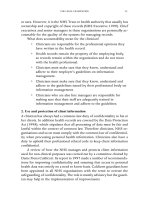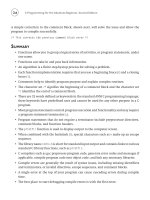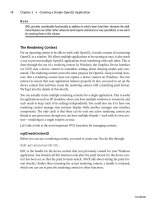Extreme Programming in Perl Robert Nagler phần 2 pps
Bạn đang xem bản rút gọn của tài liệu. Xem và tải ngay bản đầy đủ của tài liệu tại đây (200.6 KB, 19 trang )
hands and scream in exasperation, they’re saying the program misses the
mark by a mile. It’s insufficient to tell them the specification was right
or that the programmers simply misunderstood it. It’s the code users are
frustrated with, and it’s the code that is just plain wrong.
Planning and specification does not guarantee end-user satisfaction. Plan-
driven methodologies ignore requirements risk, that is, the risk that details
may be incorrect, missing, or somehow not quite what the customer wants.
When we gather requirements, write the specification, ship it off, and only
check the program against user expectations at the end, we are setting our-
selves up for failure. Requirements change in this scenario is very expensive.
This is what we se e in the Rock example. The requirements risk is propor-
tional to this time lag. Given the predominance of plan-driven software
development, it’s likely that a large numb e r of project failures are directly
attributable to too little requirements risk mitigation.
1.6 Let’s Rock And Roll
Fortunately, there is an alternative version of the Get Me a Rock story,
which solves the ill-defined requirements problem with greate r efficiency:
Boss: Get me a rock.
Peon: Sure, boss. Let’s go for a ride to the quarry.
a little while later
Boss: Thanks for pointing out this rock.
I would have missed it if I went by myself.
Peon:You’re welcome, boss.
The moral of this story is: to increase efficiency and quality, bring the
customer as close as possible to a project’s implementation.
Copyright
c
2004 Robert Nagler
All rights reserved
6
Chapter 2
Extreme Programming
XP is the most important movement in our field today.
– Tom DeMarco
Extreme Programming (XP) is an agile software-development methodol-
ogy. XP helps you remain light on your feet by avoiding unnecessary baggage
and by incorporating feedback continuously. Changing requirements are an
expected and acceptable risk, because the customer sees the system being
developed in real-time. Mistakes are immediately visible and are corrected
while the feature’s implementation is fresh and pliable, much like a potter
reworks clay.
Programmers work and rework the code in XP projects. The customer
sees a system grow from layer upon layer of detail. The software is only as
effective as the details it embodies. A tax accounting system must round
computations correctly, or it can’t be use d; it’s insufficient to get the formula
right without considering that taxes are collected in whole currency units.
Details matter, and XP programmers reflect back to the customer in the
only way that matters: working code.
All this working and reworking requires a stable base and good tools. To
throw pots effectively, you need to be seated comfortably at your potter’s
wheel, and your to ols need to be within easy reach. In the world of idea
creation, pe ople need comfort, too. They need to know what’s expected of
them and why. An XP team is expected to follow 12 simple practices. You
aren’t supposed to execute the practices blindly, however. XP gives us a
framework of four core values that lets us adjust the practices to suit our
particular project. The four core values are like a comfortable mental chair;
7
we work our code using the practices with the core values supporting our
every movement.
This chapter explains XP’s core values: communication, simplicity, feed-
back, and courage. We then enumerate XP’s 12 practices, and discuss how
to adopt them.
2.1 Core Values
XP is built on four core values: communication, simplicity, feedback, and
courage. The values reinforce each other to form a stable structure as shown
in the figure:
Core Values
The four values give the people in XP projects a firm foundation to
stand on, the why for the how. Unlike plan-driven software methodologies
mentioned in The Problem, XP is people-driven. We value people over
process.
The idea of giving people reasons (core values) for what they do (prac-
tices) is not new. For example, before XP was a twinkle in Kent Beck’s
eye, John Young, then CEO of Hewlett-Packard, stated, “We distinguish
between core values and practices; the core values don’t change, but the
Copyright
c
2004 Robert Nagler
All rights reserved
8
practices might.”
1
It’s imp ortant to trust people to judge the validity of a
practice for their particular job. They need a value system to frame their
judgments so that a person can change a practice without undermining the
goals of an organization.
The values relate to each other to form a framework. Without these
relationships, the values would not hold toge ther, and people would be less
likely to accept and to work with them. The tetrahedron symbolizes the
importance of the bonds between the values. As you read through the
descriptions in the following sections, you’ll see how the values support each
other and the practices.
2.2 Communication
A little Consideration, a little Thought for Others, makes all the
difference.
– Eeyore (A. A. Milne)
Software is developed as quickly as the communication links in the
project allow. The customer communicates her requirements to program-
mers. The programmers communicate their interpretation of the require-
ments to the computer. The computer communicates with its users. The
users communicate their satisfaction with the software to the customer.
Communication in XP is bidirectional and is based on a system of small
feedback loops. The customer asks the users what they want. The program-
mers explain technical difficulties and ask questions about the requirements.
The computer notifies the programmers of program e rrors and tes t results.
In an XP project, the communication rules are simple: all channels
are open at all times. The customer is free to talk to the programmers.
Programmers talk to the customer and users. Unfettered communication
mitigates project risk by reducing false expectations. All stakeholders know
what they can expect from the res t of the team.
2.3 Simplicity
Pooh hasn’t much Brain, but he never comes to any harm. He
does silly things and they turn out right.
1
As cited in Built to Last, Jim Collins and Jerry Porras, HarperBusiness. 1997, p. 46.
Copyright
c
2004 Robert Nagler
All rights reserved
9
– Piglet (A. A. Milne)
We all want sim ple designs and simple implementations, but simple is
an abstract concept, difficult to attain in the face of complexities. XP takes
simplicity to the extreme with practical guidelines:
• Do the simplest thing that could possibly work (DTSTTCPW),
• Represent concepts once and only once (OAOO),
• You aren’t going to need it (YAGNI), and
• Remove unused function.
Do the simplest thing that could possibly work (DTSTTCPW) means
you implement the first idea that comes to mind. This can be scary. Rely
on your courage to try out the idea. Remember that failure is an important
part of creation. It is unlikely the simplest idea is what you will end up
with. However, it’s also unlikely you can anticipate what’s wrong with your
simple solution until you try it out. Let the feedback system guide your
implementation. DTSTTCPW is simplicity as in fast and easy.
Once and only once (OAOO) helps you maintain your agility by reducing
the size of your code base. If you let conceptual redundancy permeate your
system, you have to spend more and more time rooting out faults. Every
time you copy-and-paste, you take one more step closer to bloatware. Each
copy creates an implicit coupling, which must be communicated to the rest of
the team. Be courageous, just say no to your mouse. Say yes to refactoring
the code for re-use. OAOO is simplicity as in few interchangeable parts.
You aren’t going to need it (YAGNI) is a popular and fun expletive.
If you can solve the immediate problem without introducing some feature,
that’s YAGNI! And, you simplified your problem by omission. YAGNI is
a corollary of OAOO. If you don’t have to implement the feature in the
first place, your system just took a step away from bloatware. YAGNI is
simplicity as in basic.
Sometimes you add a function for good reason but later find out the
reason is no longer valid. At this point you should delete the function. It
is unnecessary complexity. It shouldn’t require much courage, because the
code is still there in your source repository. You can always pull it out if you
need it again. Removing dead code is simplicity as in pure and uncluttered.
Copyright
c
2004 Robert Nagler
All rights reserved
10
2.4 Feedback
Well, either a tail is or isn’t there. You can’t make a mistake
about it. And yours isn’t there!
– Pooh (A. A. Milne)
The more immediate feedback, the m ore efficiently a system functions. A
simple example can be found in the shower. Some showers respond instantly
to changes in the faucet handle. Other showers don’t. I’m sure you’ve ex-
perienced showers installed by Central Services engineers from the movie
Brazil.
2
You turn on the shower, adjust the temperature, and hop into a
hailstorm or The Towering Inferno.
3
After you peel yourself off the shower
wall, you adjust the temperature, and wait a bit longer before timidly step-
ping in again. The long delay in the system makes showering unpleasant
and inefficient.
For many customers, this is what software development is like. You
request a change, and it is delivered many months later in some big release.
Often the change fails to meet your expectations, which means another
change request with yet another long delay.
XP is like a well-designed shower. You request a change and out comes
software. Adjustments are visible immediately. The customer sees her re-
quirements or corrections implemented within weeks. Programmers inte-
grate their changes every few hours, and receive code reviews and test results
every few minutes. Users see new versions every month or two.
4
The value of immediate, real world feedback should not be underesti-
mated. One of the reasons for the success of the Web is the abundance of
structured and immediate feedback from users. Developers see errors in real
time, and contract all input and output that causes Web application failures.
Users benefit from running the latest version of the software, and seemingly
on demand fault corrections. When people talk about the enduring value of
the Web in the distant future, I predict they will value the extreme acceler-
ation of user feedback and software releases. The impact of this feedback on
quality and development efficiency is what differentiates Web applications.
XP reduces project risk by taking iterative development to the extreme.
The customer’s involvement does not end at the planning phase, so re-
2
http://www.filmsite.org/braz.html
3
/>4
XP’s founders recommend multi-week iterations and releases to the customer every
three or four iterations. My experience with Extreme Perl is that an iteration per week
and one iteration per release works well, too. See Logistics for how to make this happen.
Copyright
c
2004 Robert Nagler
All rights reserved
11
quirements errors are reconciled almost immediately. The system’s internal
quality is maintained by programmers working in pairs who are striving for
simplicity. Automated testing gives everybody feedback on how well the
system is meeting expec tations.
XP uses feedback to integrate towards a solution, rather than trying to
get it through a discontinuity.
5
2.5 Courage
It is hard to be brave, when you’re only a Very Small Animal.
– Piglet (A. A. Milne)
Fear is a prime motivator, or as Napoleon Bonaparte put it, “There are
two levers for moving men: interest and fear.” With courage, our relation-
ships take on a new quality: trust. XP helps build the bonds of trust by
repeatedly exposing people to small successes.
Courage is required at all levels. Is this solution too simple? Is it too
complex? Does this test cover all the cases which could possibly break? Will
the programmers understand what I mean by the story? Will we make it to
Comdex without a detailed schedule?
We overcome fear, uncertainty, and doubt in XP with courage backed by
the other three values. A simple system is harder to break than a complex
one. Multilevel, rapid feedback lets us know quickly when our courageous
changes fail. Open communication means we don’t have to face our fears
alone. Our team members will support us. All we have to do is speak of our
fears as openly as Piglet did in the epigraph to this section. And, Rabbit
finds the right words to support him
6
:
“It is because you are a very small animal that you will be Us eful
in the adventure before us.”
Piglet was so excited at the idea of being Useful that he forgot
to be frightened any more [ ] he could hardly sit still, he was
so eager to begin being useful at once.
Sometimes we feel as small and ineffectual as Piglet. During these down-
times, it’s likely one or more of our team members feel as courageous as
5
Thanks to Johannes Rukkers for this excellent observation.
6
All A. A. Milne quotes in this chapter are from Winn ie-the-P ooh, A. A. Milne,
Dutton’s Childrens Books, 1994.
Copyright
c
2004 Robert Nagler
All rights reserved
12
Rabbit or Pooh. XP accepts that people’s emotions vary, so XP uses team
interactions to keep the project stable and to provide emotional support in
those inevitable, difficult times.
Courage is a double-edged sword. You needed to overcome your fears,
but too much courage can be dangerous. XP uses small steps to promote
courage and keep it in check. Team members se e a continuous flow of failures
and successes. XP uses small, regulated doses to discourage excess and
encourage success.
2.6 The Practices
XP’s practices embody the values described in the previous sections. In his
book Extreme Programming Explained Kent Beck defines the 12 practices
as follows (quoted verbatim):
The Planning Game Quickly determine the scope of the next release by
combining business priorities and technical estimates. As reality over-
takes the plan, update the plan.
Small releases Put a simple system into production quickly, then release
new versions on a very short cycle.
Metaphor Guide all development with a simple shared story of how the
whole system works.
Simple design The system should be designed as simply as possible at any
given moment. Extra complexity is removed as soon as it is discovered.
Testing Programmers continually write unit tests, which must run flaw-
lessly for development to continue. Customers write tests demonstrat-
ing the features are finished.
Refactoring Programmers restructure the system without changing its be-
havior to remove duplication, improve communication, simplify, or add
flexibility.
Pair programming All production code is written with two programmers
at one machine.
Collective ownership Anyone can change any code anywhere in the sys-
tem at any time.
Copyright
c
2004 Robert Nagler
All rights reserved
13
Continuous integration Integrate and build the system many times a
day, every time a task is completed.
40-hour week Work no more than 40 hours a week as a rule. Never work
overtime a second week in a row.
On-site customer Include a real, live user on the team, available full-time
to answer questions.
Coding standards Programmers write all code in accordance with rules
emphasizing communication through the co de.
These 12 simple practices realize the four core values. The remainder of
this book explains how to implement the practices in detail. Be fore we get
into implementation, let’s briefly discusses how you might adopt XP in your
organization.
2.7 Adopting XP
Organizations have their own way of doing things. There are practices,
processes and probably even some core values. In order to adopt XP, you’ll
need to work within this framework, and accept the status quo. One way
to start is to use XP in a project composed of volunteers. The project may
even be important, which is good, because your success with XP should
be visible. Once that project succeeds, pick another and let another team
coalesce around it, possibly including a few members, but not all, from the
original XP team.
You may not be in a p osition to pick and choose projects, but you prob-
ably have some latitude in how you work on a daily basis. If this is the case,
try selecting a few practices that align with your existing methodology. For
example, if your organization values testing, try test first programming. Or,
organize your day around stories. I find this technique to be helpful for non-
software problems, too, as you’ll see in Release Planning. Keep the stories
on index cards, and work through them serially. Check off each card as you
complete it.
Once you see your productivity go up, discuss the practices you found
successful with a co-worker or your manager. Use the core values as your
guide. You’ll need courage to start the communication. Keep your expla-
nations simple, focusing on the practice, not the whole of XP. Be open to
feedback, and incorporate it immediately. And, as always in XP, take small
steps and iterate.
Copyright
c
2004 Robert Nagler
All rights reserved
14
As you read through this book, look at the practices from your organi-
zation’s perspective. You’ll see plenty of ways to integrate them. XP is an
evolutionary methodology that can be adopted incrementally and organi-
cally. Even if you are the head honcho, don’t install XP with a Big Bang.
Organizations and people have their own natural pace of change. XP can-
not accelerate this rate of change overnight. Change cannot be mandated.
Rather XP values feedback and communication to allow you to measure
your progress and to inte grate change continuously.
Copyright
c
2004 Robert Nagler
All rights reserved
15
Copyright
c
2004 Robert Nagler
All rights reserved
16
Chapter 3
Perl
Perl is a language for getting your job done.
– Larry Wall
Perl is a dynamic, object-oriented, interpreted, applications program-
ming language with a full complement of security features, syntax-directed
editors, debuggers, profilers and libraries. You can also write scripts in it.
Perl lets you program any way you want, and XP helps you choose which
way is the most effective for your project.
This chapter discusses how Perl shares similar values with XP, and how
the Perl culture uses XP programming practices. Finally, we note why XP
is needed to organize Perl’s exuberance.
3.1 Core Values
Perl and XP share a similar set of values. It’s rare for programming lan-
guages and methodologies to define values at all, so this basic fact puts
Perl and XP in a unique category. We discussed XP’s values in Extreme
Programming, so let’s compare Perl’s core values to XP’s:
• Laziness means you work hard to look for the simplest solution and
that you communicate efficiently. You don’t want to misunderstand
what someone said which might cause you to do more work than you
have to.
• Impatience encourages you to do the simples t thing that could possibly
work. You use the code to communicate your understanding of the
17
problem to the customer, because you don’t like sitting through long,
boring meetings.
• Hubris is courage born from the fear your code will be too complex
for others to understand. Hubris makes you strive for positive feed-
back and to reac t quickly to negative feedback from your peers, the
computer, and the customer.
Larry Wall, Perl’s inventor, calls these values the “three great virtues of
a programmer”.
1
They tell us why Perl is the way it is: a language that
grows organically to meet the demands of its customers.
3.2 Customer-Orientation
Perl and XP were invented in the trenches. Larry Wall had to produce
reports for configuration management based on netnews.
2
Kent Beck was
tasked with saving the Chrysler Comprehensive Compensation project. Nei-
ther Perl nor XP were designed in the ivory towers of academia. Both XP
and Perl were developed to solve a specific problem, and quickly so that
Kent and Larry would kee p their jobs.
It’s too early to tell with XP, but Perl has remained true to its roots.
Perl continues to evolve based on feedback from its customers: the Perl
community. Features are added or changed if enough people clamor for
them.
This smorgasbord approach to programming languages is non-traditional,
much like XP’s focus on people over process is non-traditional in the de-
velopment methodology community. Perl gives you a wide variety of tools
without constraining how you use them. For example, Perl is object-oriented
but objects aren’t required to create modules or scripts. Perl programmers
aren’t forced to encapsulate all their code in objects to solve every problem,
especially when simpler alternatives exist.
3
XP asks you to ignore what you
aren’t going to need, and Perl lets you put this principle into action.
1
Programming Perl, 3rd Edition by Larry Wall et al, p xix.
2
This wonderful story of doing the simplest thing that could possibly work is elaborated
in Programming Perl, p. 646.
3
See Object-Oriented Programming in It’s a SMOP for an example of when objects
obfuscate.
Copyright
c
2004 Robert Nagler
All rights reserved
18
3.3 Testing
Another parallel between XP and Perl is testing. The Perl culture is steeped
in testing, and in XP, we test to get feedback from the computer and the
customer. Perl comes with a complete test suite for the language, and
virtually every CPAN (Comprehensive Perl Archive Network) module c omes
with unit tests. Testing in Perl is about impatience. It’s faster to get
accurate feedback from a unit test than by firing up the whole system to see
that it works.
It’s easy to write tests in Perl. The software quality assurance commu-
nity has long known this, and Perl is a favorite tool among testers.
4
Perl
programmers are lazy, so sometimes on CPAN the only useful documenta-
tion for a package is its tests. Some programmers find it’s easier to write
tests than documents, and conveniently that’s the XP way of doing things
anyway. Unit tests communicate exactly how to use an API, and acceptance
tests demonstrate correctness and progress to the customer.
3.4 CPAN
In XP, we share code in a collective repository. CPAN is probably the largest
collection of Perl code on the Internet. There are over 3500 open source
packages available for download. It’s also the official repository for the Perl
core implementation. Any perl programmer can get the latest version of
Perl, and perl developers check in their changes directly to CPAN. The Perl
community shares openly, because they’re lazy, and want to solve problems
once and only once.
Hubris plays a role on CPAN and in the Perl community in general. For
example, type in xml parser into , and you’ll get at
least six pages of results. It took some time for us to find the right XML
parsing package to use in It’s a SMOP. CPAN, like Perl, offers you many
more ways to do it than any one project needs.
3.5 Organizing Your Workshop
Perl is often called a Swiss Army Chainsaw. When you add in CPAN, it’s
really more like the world’s largest selection of hardware.
5
You can get lost
4
Visit , and search for Perl.
5
McGuckin Hardware in Boulder, Colorado () is the phys-
ical world equivalent of Perl.
Copyright
c
2004 Robert Nagler
All rights reserved
19
in the dizzying array of choices. Some programmers find Perl daunting.
6
This is where XP comes to the rescue. XP is the organizer in the Extreme
Perl marriage that compliments Perl, the doer and fixer. XP’s role is to keep
Perl from fixing the car when the kids need to be put to bed. XP gently
guides Perl to do the right thing for the customer.
The next few chapters show you how Extreme Perl is organized, and the
second half of this book shows you know Extreme Perl gets things done.
6
In a presentation at the 2002 PHP Conference, Michael J. Radwin lists Perl’s Motto,
“There Is More Than One Way To Do It”, as one of the three reasons Yahoo! was moving
away from Perl. Visit for
the complete presentation.
Copyright
c
2004 Robert Nagler
All rights reserved
20
Chapter 4
Release Planning
Man has an intense desire for assured knowledge.
– Albert Einstein
1
We plan to communicate our intentions and to prepare for the unplanned.
In XP, the plan evolves with feedback from building and using the system.
We adjust our intentions as we see our ideas being realized. Sometimes
reality matches what we want. Other times we gain new insight and change
our plans accordingly. XP ensures we get our recommended daily allowance
of reality checks.
Planning is a three part process in XP:
Release Planning We decide on the c ourse of action based on customer
desires and team capacity in the planning game. The result is the
release plan: a list of stories (requirements) prioritized by business
value. A release encompasses the next one to two months of work.
Iteration Planning We divvy up the stories based on individual program-
mer desires and capacity in an iteration planning meeting. An iteration
plan is a prioritized list of development tasks estimated by the people
who will be implementing them. Iterations are delivered every one to
three weeks.
Pair Programming We continuously balance between improving internal
quality and adding business function based on peer-to-peer discussions
and individual task commitments. A pair programming session lasts
1
Ideas and Opinions, Albert Einstein, Crown Publishers Inc., 1985, p. 22.
21
a few hours. The output is one or more unit tests and the software
that passes those tests.
This chapter covers release planning. The subsequent chapters discuss
the other two activities.
4.1 Planning Game
To start the ball rolling, the customer and programmers sit in a room to-
gether to define the requirements, priorities, and deadlines for the release.
We call this the planning game.
Planning is an interpersonal pro ce ss , a game, if you will. The customer
wants a long list of features, and the team wants to implement them all.
Unfortunately, the team is limited in what it can accomplish in one release.
In XP, the planning game defines the rules, pieces, and roles. The objective
is clear communication of business objectives and technical constraints.
4.2 Roles
In XP, we speak about the customer as a single person, although several
people may fill this role simultaneously. It’s imp ortant that the people
acting as the customer speak in one voice. This ensures that the project
adds business value optimally–to the the best of the customer’s knowledge.
Obviously, no one knows the optimal path, that’s why XP encourages tight
feedback loops. However, the team cannot be divided in its goals, or the
project will fail. XP has no mechanisms to resolve disputes between the
people acting as the customer.
The role of the customer is played by people who represent the collective
business interests of the project. For example, product managers, users,
and clients act as the customer. The business requirements, priorities, and
deadlines are defined by the customer.
XP defines the roles of customer and programmer unambiguously. The
customer’s job is to identify what needs to get done, and the programmers’
job is to explain how it will get done. The customer is not allowed to
say an estimate is wrong or to contradict a technical statement made by
the programmers. And, conversely, programmers cannot say a feature is
unnecessary or the customer has her priorities wrong. The planning game
is based on mutual resp e ct for these equal and distinct responsibilities.
If you are new to XP, you may want to have an impartial coach partici-
pate in your first few planning games. The planning game is non-adversarial,
Copyright
c
2004 Robert Nagler
All rights reserved
22
and a coach may help to remind people that planning is about getting as
accurate a picture as possible given limited data.
4.3 Stories
A story is how the customer communicates a requirement in XP. The content
of a story is simple, usually one or two sentences. Here are some actual
stories:
GenderTags The questions and answers will be customized with the name
of the bride and groom where applicable.
InstallDisks Figure out which computer to use, and install disks. Make
available via Samba and NFS.
SubscriptionStartEnd Subscription start/end dates should not overlap.
DemoClubUpdate Update data in demo club. Include AccountSync en-
tries.
DBExportSplit file t is too large for a single export file. Need to figure
out how to split.
ECtoQB Convert EC payments to QuickBooks IIF format. Group checks
into deposits.
CloseChase Move account to Wells Fargo.
For the most part, the customer writes the stories. Note the incomplete-
ness of the stories in some cases. For example, DemoClubUpdate doesn’t
specify what data is required. If the programmer needs more info, he will
ask the customer when he starts implementing the story.
Some of these example stories were not written by the customer, for
example, DBExportSplit and InstallDisks. Technical stories come up during
implementation, but it is the c ustomer who decides how important they are.
The programmers’ job is to note the technical need on a story card, and to
present the business case to the customer during the planning game.
4.4 On-site Customer
The customer does not write the stories and say, “get to it!” There is an
explicit trade-off with simple requirements; the customer must stick around
Copyright
c
2004 Robert Nagler
All rights reserved
23
for the implementation. She must be available to the programmers to fill in
the details during execution of the plan.
A story is not sufficient criteria for acceptance. Part of the customer’s
job is to write the acceptance tests with the help of the programmers. Perl
makes this easy. Acceptance Testing explains how in detail.
4.5 Story Cards
The stories are written on story cards. Here’s the CloseChase story card:
Close Chase Story Card
I use story cards for almost everything. In this case, it’s an administra-
tion problem. The mechanism is always the same: when there is a problem
to solve, write it on a story card. It represents a work item, and all work
items need to be put in the queue.
It often is a good idea to prepare story cards before the planning game.
Everybody should keep a stack on their desks. The customer may think
of new stories while using the system. The programmers m ay encounter
internal quality problems while coding.
There is no officially-sanctioned XP story card. Each project may need
special customizations. This s tory card is one we have developed for our
company’s needs.
2
Here’s the way we interpret the fields:
2
The source can be found at .
Copyright
c
2004 Robert Nagler
All rights reserved
24









